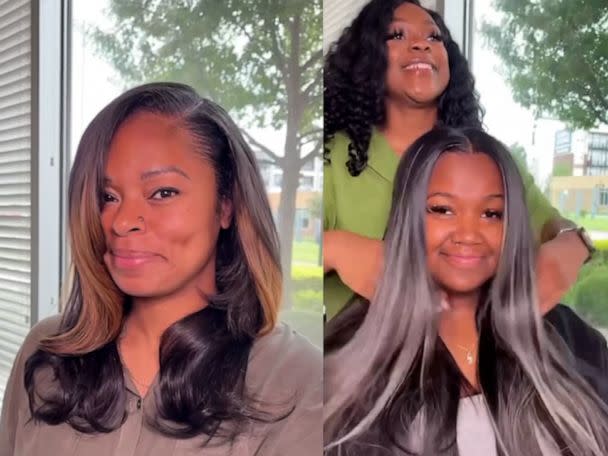What are tape-in hair extensions? Hairstylist breaks down pros, cons, pricing and more

When it comes to hair extensions, there are many, many options.
The latest obsession comes in tape-in form.
Tape-in hair extensions are sections of hair that are pre-taped with medical-grade glue by a licensed cosmetologist. This kind of install is perfect for anyone looking for extra length, fullness and maximum versatility -- along with minimal tension.
"I think tape-in extensions have grown in popularity because there have been more stylists promoting it on Black hair," Dallas-based natural hair and extension specialist Jayla Hamilton told "Good Morning America."
"There's something about the way you can tape extensions on natural hair," she said. "It's very interesting to see."
While there are thousands of tape-in videos on TikTok and Instagram, it's important to know the expert do's, don'ts and best practices if you are looking to try this type of extension.
Hamilton, who services clients daily, explained what you should remember when booking an appointment.
Pros and cons of getting tape-in hair extensions
Available in a wide variety of hair textures, ranging from pin straight to tightly curled, one of the pros of getting tape-ins is that you can achieve natural-looking extensions with length and volume, minus any tension. "There is no braiding, sewing, or gluing involved," said Hamilton.
She also pointed out that if you were to pull your hair up in a ponytail, the extensions would lay flat and seamless.
"Tape-ins really stand out because people are so intrigued by the fact that you are literally taping hair to your head," Hamilton said. "I know some of my clients are amazed that I can shampoo their hair without the tapes sliding out. You can also reuse the extensions depending on the quality of the hair."
When it comes to the cons, one of the most significant is that tape-ins are a temporary style -- and routine salon maintenance is vital. "If your tape-ins are not taken care of properly, it can cause matting and breakage," said Hamilton.
What happens during a tape-in hair consultation?
"During a consultation, I always ask my clients what they are looking for when it comes to tape-in extensions," said Hamilton. "My clients wear their hair straightened, so I personally do not texture match with this install, though some stylists do."
"I ask my clients how they feel about their curl pattern stretching over time," she continued. "The majority do not mind it, but if they prefer not to have their hair straightened, I can't proceed with the install. I let them know what maintenance entails, the cost, and when they should be removed."
Who is a good candidate for tape-in hair extensions?
The best candidate for a tape-in service is someone with enough hair to cover or disguise the tape, "at least bob length," suggested Hamilton. Both fine or coarse hair types are safe for tape-in extensions, but anyone experiencing extreme shedding or scalp issues such as seborrheic dermatitis should not try this type of install.
Hamilton also affirmed that if you are not willing to come back to the salon for maintenance or follow the at-home care instructions from your stylist, tape-ins may not be an ideal option to try.
Tape-in installation process
Step 1: Tape-in hair services start with shampooing, conditioning, blow drying, straightening and trimming the hair.
Step 2: A sandwich-like method is used on quarter-inch subsections of hair. The tape is placed under each section (not too close to the scalp), smoothed down, and another tape is placed on top and smoothed down.
Step 3: The stylist will tap the tape with a hair iron on low heat to seal it before following this bricklayer pattern in rows around your head.
Maintenance tips
When maintaining your tape-in install, it's best to brush and wrap the hair every day. "I would not recommend oiling or greasing the scalp because it could cause the tape-ins to slip," said Hamilton.
Pro tip: If you feel like your hair is getting too dirty before your next appointment, use a dry shampoo to aid in reducing the greasy feel or look of your hair.
Tape-ins vs. microlinks
Last year, "GMA" reported on the craze around microlink hair extensions which are tiny sections of hair that are seamlessly grouped together and secured with a micro-ring or micro-bead using a hair plier. This install has a similar result as tape-ins, but there are clear differences.
"Microlinks give you length and fullness while tape-ins give you length and volume," said Hamilton. She also highlighted that microlinks will last longer than tape-in extensions.
MORE: Considering micro-link hair extensions? Read this first.
How long do tape-in hair extensions last and how are they removed?
Tape-ins can last six to 10 weeks with proper maintenance and at-home care. To remove, use a tape-in removal spray, which can be found at beauty supply stores or mass retailers such as Amazon, to loosen the adhesive and make it easy for the natural hair to be separated from the tape.
Price range
Prices tend to vary depending on added treatments and how many tapes are used, but the typical cost can range from $300-$600.
Clients with fine hair generally need 40-60 tape strips, medium thick hair needs 50-70 strips and thick hair needs 60-80 strips.
What are tape-in hair extensions? Hairstylist breaks down pros, cons, pricing and more originally appeared on goodmorningamerica.com